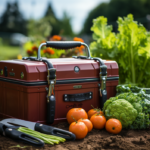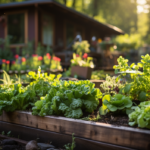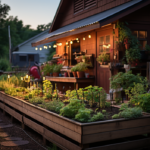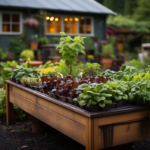Table of Contents
Maximize Your Garden Yield with These Money-Saving Tips and Tricks for a Stunning Kitchen Garden
Do you love the idea of having your own vegetable garden, but the cost of supplies and tools has kept you from starting one? Fret not, because creating a budget-friendly kitchen garden is easier than you think.
With a little planning and creativity, you can grow fresh produce to cook with all year round without breaking the bank. Not only is it cost-effective, but it’s also an excellent way to eat healthily and be environmentally friendly.
In this article, we will show you how to create a beautiful kitchen garden on a budget. From choosing the right plants to maximizing space and resources, we will cover everything you need to know to get started. Whether you have a small balcony or a spacious backyard, you’ll find tips and tricks that suit your needs. So roll up your sleeves and let’s get started!
Choosing the Right Plants
Growing a successful kitchen garden on a budget requires careful planning, and selecting the right plants is crucial. Here are some considerations when choosing the plants for your garden:
Pick Seasonal Vegetables
One of the critical factors in selecting plants for your kitchen garden is timing. Choosing vegetables that grow naturally in your region and are in-season ensures better yields, tastier flavors, and lower costs as these plants require fewer resources.
Plan Your Space
Whether you have a small balcony or a large yard, it’s essential to figure out how much space you have to work with. Small gardens can be just as productive as larger ones if planned and maintained properly. Bushy vegetables such as cucumbers and zucchini have a significant yield and take up little space, making them ideal for small gardens.
Buy Seedlings
Growing plants from seed is more cost-effective; however, it’s time-consuming and can be challenging for beginners. Additionally, buying seedlings from your local nursery is less expensive than buying mature plants.
Select Companion Plants
Choosing companion plants for your vegetables is vital in preventing pest infestations, soil deficiency, and promoting pollination, leading to larger, healthier yields. Pairing basil with tomatoes, for example, deters pesky bugs from attacking your tomato plants.
Choose the Right Type of Soil
The soil type determines the overall health and productivity of your garden. Potting soil, for example, is ideal for container gardening but can become expensive when working with larger gardens. Soil mixtures of compost and other organic materials can be an excellent cost-effective alternative.
In conclusion, selecting the right plants for your kitchen garden on a budget is about finding a balance between yield, maintenance, and resources. Ensure that you choose seasonal vegetables, buy seedlings, plan your space accordingly, and select companion plants to maximize your yield. With these tips, you can create a lush and productive kitchen garden without breaking the bank.
Maximizing Space and Resources
When creating a budget-friendly kitchen garden, it’s essential to maximize the space and resources available. Here are some tips to help you do just that:
Vertical Gardening
Vertical vegetable gardens are ideal for small spaces or urban environments, as they take advantage of the vertical space. There are several ways to create a vertical garden, including trellises, hanging baskets, and wall-mounted grow bags.
Companion Planting
Pairing the right plants together is not only beneficial for the plants’ health, but it can also help maximize your garden’s space. This is known as companion planting and includes growing vine tomatoes beside pole beans, as beans provide natural support to the tomatoes.
Container Gardening
Container gardening is an excellent option for those with limited space and can be done using any container that can hold soil. Vegetables such as lettuce, radishes, and spinach are ideal for container gardening, while larger plants such as tomatoes and peppers require more significant containers.
Repurposing Household Items
Many household items can be repurposed as garden tools, including old boots, cooking pots, and plastic containers. These items can be used as planters or as supportive structures for plants like bean trellises.
Composting
Creating your compost is a great way to fertilize your garden, and it’s also an excellent way to reduce your food waste. Composting can be done using much of your household waste like vegetable trimmings, coffee grounds, and eggshells.
In conclusion, maximizing your space and resources when creating a budget-friendly kitchen garden is essential. Vertical gardening, container gardening, and composting are great cost-effective ways to maximize your garden space, and repurposing household items is a great way to recycle common household items. By using these tips, you can create a thriving kitchen garden that is not only budget-friendly but also environmentally friendly.
Creating a Compost Bin
Composting is an important aspect of creating a budget-friendly kitchen garden. It’s a simple process that helps reduce household waste while providing valuable nutrients for your garden. Here are some tips to help you create a cost-effective composting bin.
Decide on a Bin Type
There are various types of composting bins you can use, consider these:
- Tumbling bins: convenient to use, but can be expensive.
- Wire-mesh bins
- Wooden pallet bins
- DIY bins made from old plastic containers.
Choose a Composting Method
Composting can be done using various methods, depending on the type of bin you choose to use. The three main methods are:
- Cold composting: This is the easiest method of composting, but it can take between six months to two years to produce usable compost.
- Hot composting: This method is much faster and can produce useable compost within a matter of weeks but requires more maintenance.
- Vermicomposting: This process involves using specific worms to break down organic material into compost. It’s perfect for small spaces and indoor composting.
Add the Composting Materials
To create useable compost, you need to add a mixture of browns (carbon-rich materials) and greens (nitrogen-rich materials) to your compost bin. Browns include things like dry leaves, wood chips, and sawdust; greens include things like grass trimmings, vegetable scraps, and coffee grounds.
Maintain the Composting Bin
To promote the optimal breakdown of your compost, turn it regularly and keep it moist. Regular turning helps to add oxygen and balance the carbon-to-nitrogen ratio while moisture and heat promote microbial growth in the bin.
In conclusion, creating a compost bin is a cost-effective way to create useful fertilizer for your kitchen garden. When creating a compost bin, choose a bin type, decide on a composting method, add the composting materials, and maintain the bin. Using compost produced from your compost bin is an environmentally friendly way to reduce waste, improve soil structure, and increase plant yield in your garden.
Repurposing Household Items as Garden Tools
Purchasing gardening tools can be expensive, but you can repurpose many household items as garden tools to help cut costs. Here are some of the best household items you can use in your garden:
Old Boots
Instead of disposing of your old rain boots, you can repurpose them as planters. They add character to your garden and are perfect for planting shallow-rooted plants such as herbs and small flowers.
Eggshells
Eggshells are an excellent source of calcium, which is essential for healthy plant growth. Crushed eggshells can be used as a natural fertilizer for your garden, and they also deter pests such as slugs and snails.
Plastic Containers
Buckets, plastic crates, and containers can all be repurposed as planters. They are durable and can be painted or decorated to match your garden’s theme.
Cooking Pots and Pans
Old cooking pots and pans can be used as makeshift planters for vegetables and herbs and small flowers. They are perfect for growing small plants in reduced spaces.
Ladder
An old ladder can be repurposed as a vertical garden that can be used for climbing plants or to hang baskets of flowers.
Clothespins
Clothespins can be used to support plants that need staking such as tomato plants. You can use them to clip the stalks to stakes, so they grow upright.
Repurposing household items as gardening tools is an excellent way to create a budget-friendly kitchen garden. Old boots, eggshells, plastic containers, cooking pots and pans, ladders, and clothespins are all great items that can be repurposed for your garden. Not only does this approach save you money, but it’s also environmentally friendly and fantastic for recycling! With a little creativity, you can turn items you already own into useful tools for your garden, which will help you create an eco-friendly and fantastic space for growing your favorite plants.
Conclusion
Creating a budget-friendly kitchen garden is all about getting creative and maximizing your resources. With careful planning and the use of cost-effective techniques, you can create a productive and beautiful garden that provides you with fresh produce all year round. In this article, we’ve covered the essential aspects of creating a budget-friendly kitchen garden, including selecting the right plants for your garden, maximizing space and resources, creating a compost bin, and repurposing household items as garden tools. By following these tips, you can save money, reduce waste, and promote sustainable living. So, plant those seeds, water those plants, and watch your garden grow! Creating a beautiful kitchen garden doesn’t have to be expensive, and with these cost-effective tips, you can create a luscious garden that will bring you joy and fresh produce for years to come.









